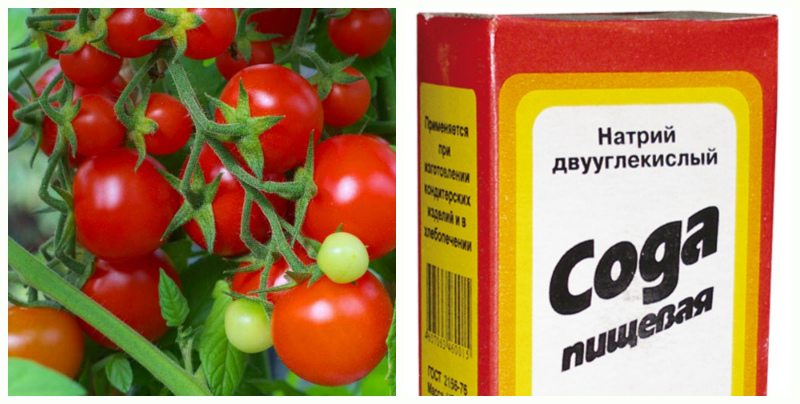 To grow a good tomato crop, many gardeners resort to fertilizer. Using ordinary baking soda will be an effective tool for processing tomatoes. It is convenient and easy to breed, and the powder itself is in almost every home.
To grow a good tomato crop, many gardeners resort to fertilizer. Using ordinary baking soda will be an effective tool for processing tomatoes. It is convenient and easy to breed, and the powder itself is in almost every home.
Content
Beneficial features
In addition to being widely used in everyday life, sodium bicarbonate has been used in the garden for decades. The main property of soda is disinfection. Getting on tomato leaves and a stalk, the powder leads to the death of pathogenic microorganisms, repels pests. Unlike antifungal fungicides, soda is not at all dangerous for both humans and tomatoes. You can prepare its solution without glasses and gloves; as a result of mixing it with water, toxins and unpleasant odors are not formed.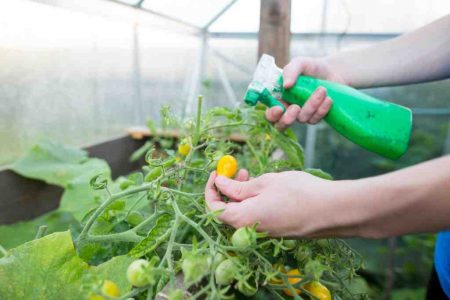
Soda has the following advantages:
- Prevents the formation of powdery mildew, late blight and other diseases on bushes and in the ground.
- Improves the immune qualities of tomatoes, prevents premature wilting of bushes.
- Improves the taste of fruits.
- Increases seedling growth.
- Reduces soil acidity.
However, the use of soda is not always advisable. A good result with root dressing is especially noticeable on acidic soil. It is not permissible to use bicarbonate for alkalized soil, since it increases the pH, as a result of which tomatoes can die.
Baking soda can be used for root, but more often foliar top dressing. The first treatment is carried out in late spring, 2-3 weeks after transplanting tomatoes into a greenhouse or open ground. The second and third treatments are carried out in increments of 2 weeks.
The number of top dressings used should not exceed 3 for the entire time of cultivation.
Seed soaking
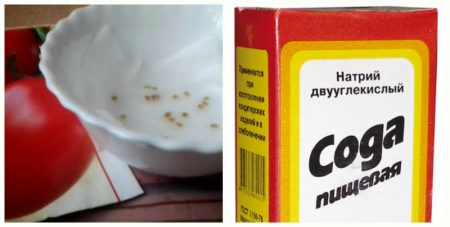 Before planting seeds, they must be processed in a disinfectant solution. Untreated seeds do not grow well, look weakened after transplanting, and are also easily infected by viruses and diseases. To avoid unpleasant consequences, dilute a weak soda solution: 5 grams of substance are taken per 500 milliliters of water. Dry seeds are lowered into the resulting solution and incubated for 2-3 hours until they swell. Then the grains are removed, washed with warm water and slightly dried with a towel. The grains are disinfected and ready for planting in the ground.
Before planting seeds, they must be processed in a disinfectant solution. Untreated seeds do not grow well, look weakened after transplanting, and are also easily infected by viruses and diseases. To avoid unpleasant consequences, dilute a weak soda solution: 5 grams of substance are taken per 500 milliliters of water. Dry seeds are lowered into the resulting solution and incubated for 2-3 hours until they swell. Then the grains are removed, washed with warm water and slightly dried with a towel. The grains are disinfected and ready for planting in the ground.
For soil and compost
Pathogenic microflora can develop not only on seeds, but also on planting ground. Before transplanting seedlings into the ground, it is treated with a soda solution. Take a tablespoon of sodium bicarbonate in a bucket of water and dissolve it in a bucket of warm water, mix well. Compost or earth is watered a few days before the tomato transplant. Such irrigation will provide reliable protection against possible diseases.
To control pests and diseases
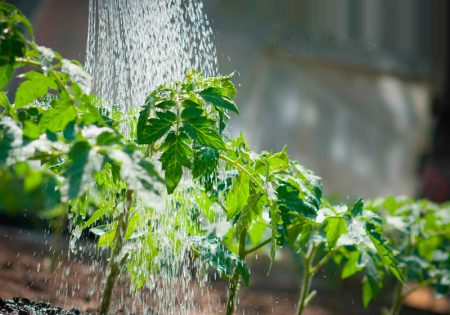 When the seedlings are planted, they must be treated for attack from aphids, midges, ticks, spiders, as well as from diseases. 5 tablespoons of sodium bicarbonate are bred into a bucket of water and irrigated shoots. To enhance the action, you can add to the mixture 40 grams of laundry soap, crushed on a grater. Apply the prepared mixture to the shoots and stems using a water gun or spray gun. Alkaline environment prevents the formation of powdery mildew, late blight on plants. Processing is carried out at a time, 2 weeks after transplantation.
When the seedlings are planted, they must be treated for attack from aphids, midges, ticks, spiders, as well as from diseases. 5 tablespoons of sodium bicarbonate are bred into a bucket of water and irrigated shoots. To enhance the action, you can add to the mixture 40 grams of laundry soap, crushed on a grater. Apply the prepared mixture to the shoots and stems using a water gun or spray gun. Alkaline environment prevents the formation of powdery mildew, late blight on plants. Processing is carried out at a time, 2 weeks after transplantation.
From pests and diseases, another no less effective mixture helps. On a bucket of water you need to take a tablespoon of copper sulfate and bicarbonate. Tomatoes are sprayed with the resulting solution.
For dilution use water at room temperature.
Root feeding
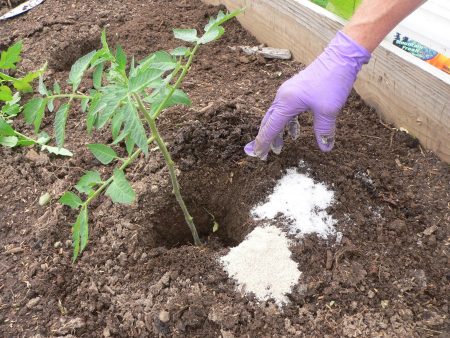 So that the tomatoes grow juicy and healthy, and their taste is at their best, water the soil mixture with diluted soda solution. Dissolve a teaspoon in 5 liters of warm water and pour the tomatoes under the root. Fertilizer is used 2-3 times for the entire season, no more. Usually, the treatment is carried out 2 times in July and again in August. This type of feed is suitable only for areas in which the soil has a low pH. During root dressing of plants, foliar treatment from pests and diseases can be carried out.
So that the tomatoes grow juicy and healthy, and their taste is at their best, water the soil mixture with diluted soda solution. Dissolve a teaspoon in 5 liters of warm water and pour the tomatoes under the root. Fertilizer is used 2-3 times for the entire season, no more. Usually, the treatment is carried out 2 times in July and again in August. This type of feed is suitable only for areas in which the soil has a low pH. During root dressing of plants, foliar treatment from pests and diseases can be carried out.
Fertilizer Recommendations
Soda will certainly benefit tomatoes if its use is extremely correct. Failure to proportion when watering or irrigating the leaves can cause a chemical burn. Before you start processing plants, you need to study some of the nuances:
- The concentration of the bicarbonate solution in any application should not exceed 5%.
- Irrigation is best done in the morning. Spray should be small, so they are evenly distributed on the surface of the leaves and stem.
- The frequency of processing should not exceed 10 days.
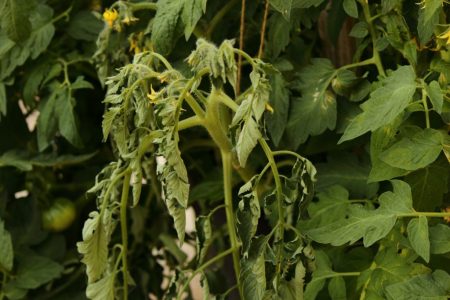 If it is noticed that the tomatoes fade after soda processing, and yellowing appears on the leaves, the use of the additive is temporarily stopped. Perhaps such a reaction is caused due to an incorrectly selected concentration of the solution or due to the high alkaline reaction of the soil.
If it is noticed that the tomatoes fade after soda processing, and yellowing appears on the leaves, the use of the additive is temporarily stopped. Perhaps such a reaction is caused due to an incorrectly selected concentration of the solution or due to the high alkaline reaction of the soil.
Reviews
In fact, about the use of soda in growing tomatoes, the reviews are mixed. Someone is quite happy with the supplement and annually conducts disease prevention using bicarbonate only. Others speak negatively about the fertilizer, talk about its aggressiveness and the high probability of getting serious burns on the foliage. In order not to encounter troubles of this kind, it is better to try a soda solution on a pair of bushes and observe their condition. If top dressing has benefited, it continues to be used.
Those who carry out disease prevention with the help of soda, recommend combining it with foliar feeding with potassium permanganate. The resulting solution should be a light pink color. Spray a mixture of tomatoes in early or mid-May. The effectiveness of such treatment is increased significantly, and the risk of contracting a disease completely disappears.
When root feeding soda, it is advised to add a couple of drops of iodine or a tablespoon of potassium sulfate to enrich the solution with trace elements. Potassium and iodine favorably affect the taste of the fruit and the structure of the pulp, as well as increase productivity.
Soda is considered more an aid in the cultivation of tomatoes, in addition to it, other complex additives, mineral and organic fertilizers must be used. When combined, it always turns out to grow a healthy crop of high quality.




 Low-growing tomatoes, without pinching: 5 of the most delicious varieties
Low-growing tomatoes, without pinching: 5 of the most delicious varieties Why tomato seedlings grow poorly
Why tomato seedlings grow poorly We grow a tomato in a shell
We grow a tomato in a shell Growing tomatoes without watering according to the method of Kazarin
Growing tomatoes without watering according to the method of Kazarin
burned all the cabbage sprinkled as recommended
GALINA
Soda is by no means used to deoxidize the soil. They started to learn everything directly ... process the garden for 20 years - then give advice.